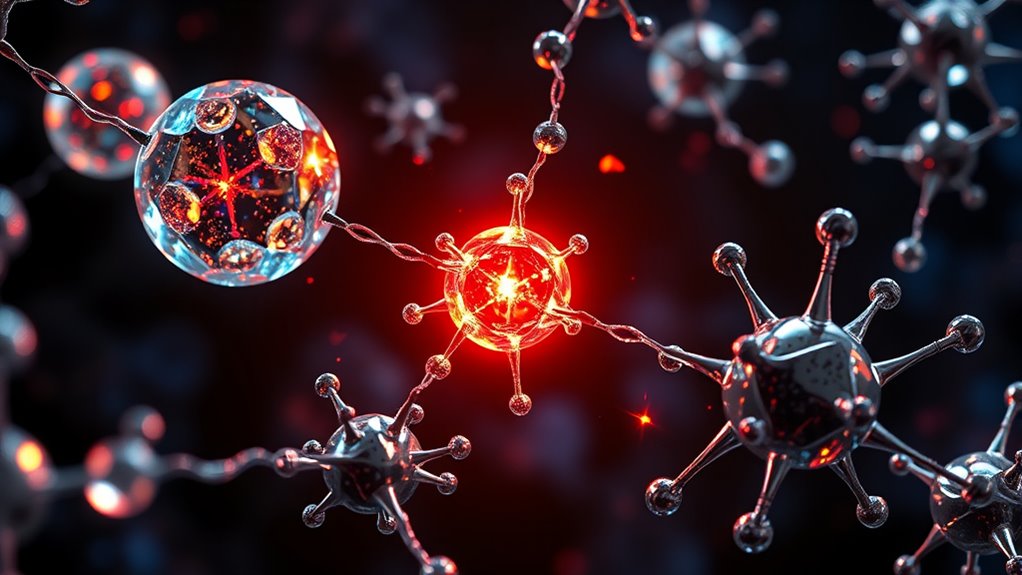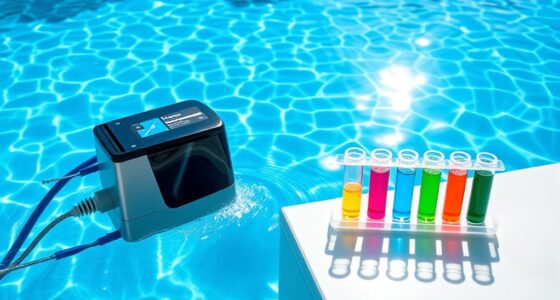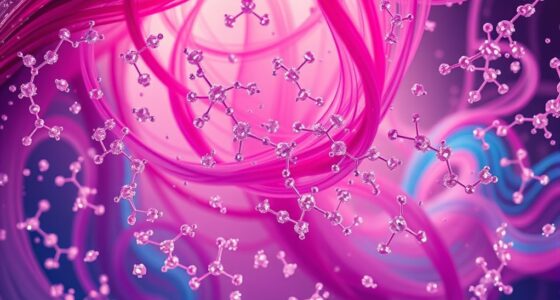Antioxidants work at the molecular level by donating electrons to neutralize free radicals, which are unstable molecules with unpaired electrons that can damage your cells. Their chemical structures, like phenolic groups and conjugated double bonds, enable this electron transfer, stabilizing reactive species and preventing chain reactions that harm proteins, DNA, and cell membranes. This balance between free radicals and antioxidants is essential for your cellular health; exploring further reveals how these processes protect your body at the microscopic level.
Key Takeaways
- Antioxidants donate electrons to free radicals, neutralizing their reactivity and preventing cellular damage.
- Structural features like conjugated double bonds and hydroxyl groups stabilize antioxidants and enhance their radical-scavenging ability.
- They stabilize free radicals through resonance and resonance stabilization, preventing chain reactions of oxidative damage.
- Electron transfer mechanisms, such as hydrogen atom transfer, enable antioxidants to effectively reduce reactive species.
- Synergistic interactions among antioxidants amplify their capacity to neutralize free radicals at the molecular level.
The Nature of Free Radicals and Oxidative Stress

Have you ever wondered how your body fights off harmful molecules that can cause damage? Free radicals are unstable molecules with unpaired electrons, produced naturally during metabolic processes like those involving oxidative enzymes. These molecules participate in free radical signaling, which helps regulate cell functions. However, when free radicals accumulate excessively, they cause oxidative stress, damaging proteins, DNA, and cell membranes. This imbalance occurs when free radical production outpaces your body’s ability to neutralize them with antioxidants. Understanding this process reveals how oxidative stress contributes to aging and disease. Your body constantly balances free radical signaling to maintain health, but an overload can overwhelm defenses, leading to cellular damage. Recognizing this dynamic highlights the importance of managing free radical levels for overall well-being.
Chemical Structure of Antioxidants

Antioxidants neutralize free radicals through their specific chemical structures, which allow them to donate electrons and stabilize these reactive molecules. The molecular conformations of antioxidants influence how effectively they can interact with free radicals, enabling ideal positioning of reactive sites. The chemical bonding, especially the presence of conjugated double bonds and functional groups like hydroxyl or phenolic groups, plays a vital role in their stability and reactivity. These bonds help distribute unpaired electrons, making antioxidants more capable of donating electrons without becoming unstable themselves. The arrangement of atoms within the molecule determines its ability to absorb and neutralize free radicals efficiently. Additionally, the molecular conformations of antioxidants are crucial in determining their effectiveness in counteracting oxidative stress. The presence of chemical bonding patterns also affects how antioxidants interact with other molecules in biological systems, influencing their overall protective functions. Moreover, the molecular structure of antioxidants impacts their ability to function effectively in different biological environments, optimizing their protective capabilities. Overall, the molecular conformations and chemical bonding patterns are fundamental to understanding how antioxidants perform their protective functions at the molecular level.
Electron Donation and Radical Scavenging

You can think of antioxidants as molecules that donate electrons to neutralize free radicals, preventing cellular damage. This process involves electron transfer mechanisms that stabilize reactive species and stop chain reactions. Additionally, antioxidants often regenerate through specific processes, maintaining their protective abilities over time. Automation in business demonstrates how technological advancements can streamline processes and enhance efficiency, similar to how antioxidants protect cells by neutralizing harmful agents. Some antioxidants are also known for their ability to react with multiple free radicals, which amplifies their protective effects in biological systems. Moreover, the molecular structure of antioxidants influences their capacity to donate electrons and scavenge radicals effectively.
Electron Transfer Mechanisms
How do antioxidants neutralize harmful radicals at the molecular level? It all comes down to electron transfer. When a reactive radical encounters an antioxidant, molecular interactions occur that enable the antioxidant to donate an electron. This electron donation stabilizes the radical, preventing it from damaging nearby molecules like DNA or lipids. The process involves direct electron transfer, which effectively neutralizes the reactive species. Unlike simple scavenging, this mechanism relies on the antioxidant’s ability to participate in electron transfer reactions, often facilitated by specific structural features. By acting as electron donors, antioxidants interrupt chain reactions initiated by free radicals. This electron transfer mechanism is essential for maintaining cellular integrity and protecting your body’s molecules from oxidative stress.
Free Radical Neutralization
When a reactive free radical encounters an antioxidant, the process of neutralization begins through radical scavenging and electron donation. You provide electrons to stabilize the free radical, stopping chain reactions that cause cellular damage. Antioxidant synergy enhances this process, as multiple antioxidants work together for more effective neutralization. This prevents oxidative signaling from triggering harmful pathways. Here’s a simplified look:
| Free Radical | Antioxidant | Result |
|---|---|---|
| OH• | Vitamin C | Neutralized, no damage |
| Superoxide (O2•−) | Enzymes like SOD | Converts to less reactive forms |
| Lipid radical | Vitamin E | Stops lipid peroxidation |
| ROS | Glutathione | Regulates cellular signaling |
This coordinated action ensures your cells stay protected and healthy, supported by antioxidant mechanisms that maintain cellular integrity. Understanding how free radicals are neutralized at the molecular level highlights the importance of a balanced antioxidant intake for overall health.
Antioxidant Regeneration Processes
Have you ever wondered how antioxidants maintain their protective power after neutralizing free radicals? It’s through processes like antioxidant regeneration and redox cycling. When an antioxidant donates an electron to a free radical, it becomes oxidized. To continue functioning, it must undergo antioxidant regeneration, where it gains an electron again. This cycle is essential for sustained protection. Key mechanisms include:
- Redox cycling, where antioxidants repeatedly donate and accept electrons, preserving their activity.
- Electron donation, which neutralizes free radicals but can leave the antioxidant temporarily oxidized.
- Regeneration pathways, involving enzymes or other antioxidants that restore the oxidized antioxidant to its active form.
- The efficiency of these processes depends on the antioxidant’s molecular structure and its ability to participate in electron transfer reactions. Additionally, cellular environment can influence how effectively these regeneration mechanisms occur. Moreover, oxidative stress can impact the availability of molecules involved in regeneration pathways, affecting overall antioxidant capacity.
This continuous electron exchange ensures antioxidants stay effective longer, providing ongoing defense against oxidative stress.
Types of Antioxidant Reactions
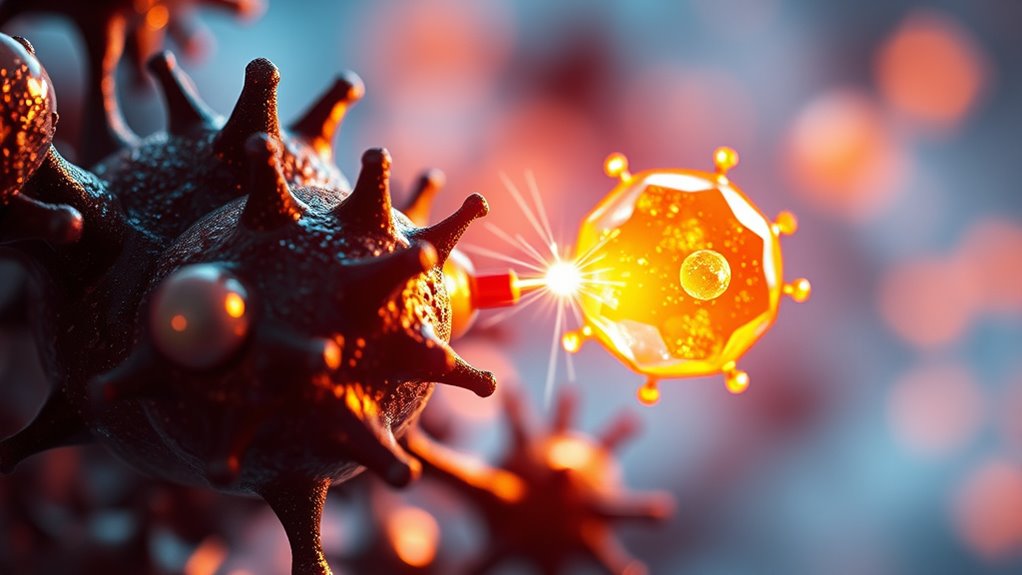
What types of reactions do antioxidants use to neutralize free radicals? They primarily engage in reduction, donation, and scavenging reactions. These processes involve antioxidant enzyme mechanisms that catalyze the breakdown of reactive species or directly neutralize them. For example, some antioxidants donate electrons to free radicals, stabilizing them and preventing cellular damage. In synthetic antioxidant design, scientists create molecules that mimic natural antioxidants, enhancing their reaction efficiency. Understanding these mechanisms is crucial for developing more effective antioxidant therapies. Recognizing the molecular interactions involved helps scientists tailor antioxidants for specific health applications. Here’s a quick overview:
| Reaction Type | Mechanism | Example |
|---|---|---|
| Hydrogen atom transfer | Transfers H• to neutralize free radicals | Vitamin E donating hydrogen |
| Electron transfer | Donates electrons directly | Ascorbate reducing ROS |
| Catalytic reactions | Enzymatic breakdown | Antioxidant enzyme mechanisms |
| Radical addition | Bonds with free radicals | Synthetic antioxidants’ design |
Role of Free Radicals in Cellular Damage
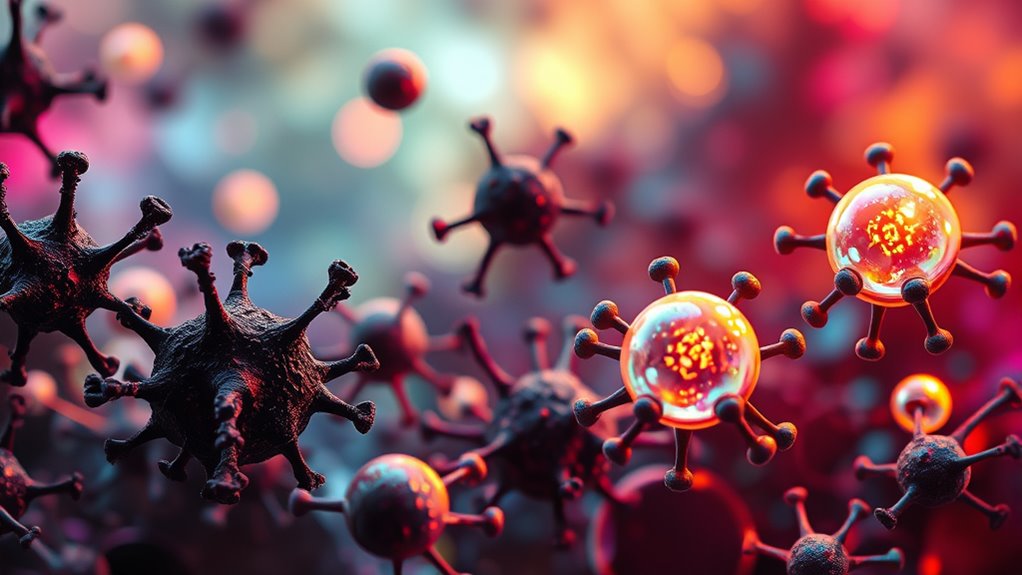
Antioxidants combat free radicals by neutralizing their reactive nature, but if left unchecked, free radicals can cause significant cellular damage. This process involves oxidative damage, which disrupts cell structures and impairs functions. Free radical formation often occurs during normal metabolic processes or from environmental stressors like pollution and radiation. If your body doesn’t counteract these reactive molecules, they can:
Free radicals cause cell damage; antioxidants help neutralize them to protect your health.
- Damage DNA, leading to mutations and potential disease development.
- Peroxidize lipids in cell membranes, compromising cell integrity.
- Inactivate essential enzymes, impairing cellular metabolism.
– Modern heat pumps utilize innovative technology, including variable-speed compressors and smart thermostats, to enhance performance. Efficiency ratings are crucial for selecting models that provide better energy savings and performance. Additionally, protective mechanisms in cells help limit the extent of free radical damage, emphasizing the importance of antioxidants in maintaining cellular health. Maintaining a healthy balance between free radicals and antioxidants is essential for preventing oxidative stress, which is linked to aging and various chronic diseases.
Key Antioxidants in the Human Body
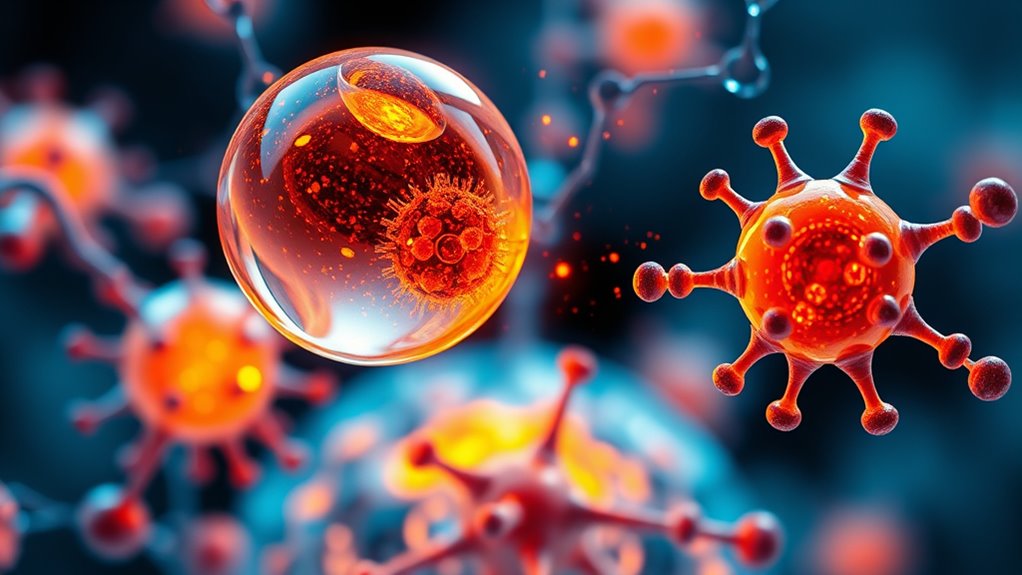
Your body relies on key endogenous antioxidants like glutathione, superoxide dismutase, and catalase to neutralize harmful free radicals. You can also boost your defenses through dietary sources such as fruits, vegetables, nuts, and whole grains. Understanding these antioxidants helps you make choices that support your overall health and cellular protection. Incorporating antioxidant-rich foods into your diet can further enhance your body’s natural defenses against oxidative stress. Additionally, understanding the specific roles of immune system components can offer insights into how your body defends itself at the molecular level.
Common Endogenous Antioxidants
The human body relies on several key endogenous antioxidants to neutralize harmful free radicals and maintain cellular health. These antioxidants include enzymes and molecules produced naturally within your body. Three main examples are:
- Superoxide dismutase (SOD): An endogenous enzyme that converts superoxide radicals into hydrogen peroxide, reducing oxidative stress. Its activity can be influenced by various factors, including antioxidant gene regulation, which controls its expression levels.
- Glutathione (GSH): A tripeptide that directly neutralizes free radicals and regenerates other antioxidants.
- Catalase: An enzyme that breaks down hydrogen peroxide into water and oxygen, preventing cellular damage.
These antioxidants are regulated by specific antioxidant genes, which control their expression. Your body’s endogenous enzyme systems work synergistically to protect cells from oxidative damage, maintaining overall health and resilience. Additionally, understanding how antioxidant pathways function can help in developing strategies to enhance cellular defense mechanisms.
Dietary Sources of Antioxidants
Ever wondered where you can find antioxidants beyond supplements and medicine cabinets? Your diet offers rich sources like various fruit varieties and herbal supplements. Fruits such as berries, citrus, and grapes are packed with flavonoids and vitamin C, boosting your body’s defenses. Herbal supplements like green tea extract and turmeric provide potent antioxidants like catechins and curcumin. Here’s a quick overview:
| Fruit Varieties | Herbal Supplements | Key Antioxidants |
|---|---|---|
| Berries | Green tea | Catechins |
| Citrus fruits | Turmeric | Curcumin |
| Grapes | Ginseng | Ginsenosides |
| Apples | Milk thistle | Silymarin |
| Plums | Rosemary | Carnosic acid |
Incorporate these foods into your diet to naturally enhance your antioxidant levels.
How Antioxidants Stabilize Free Radicals
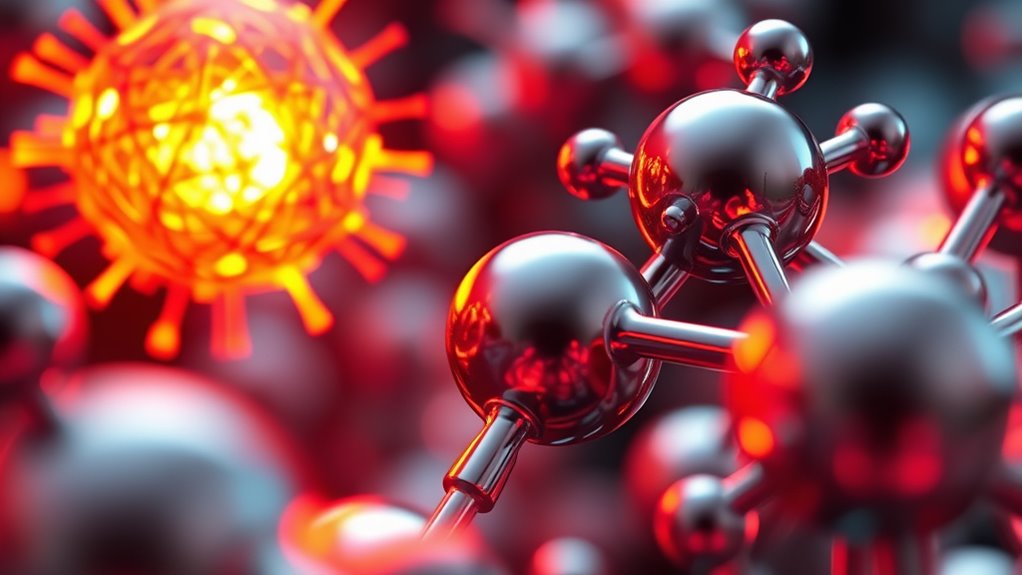
Free radicals are highly reactive molecules with unpaired electrons, which makes them prone to damaging cells and tissues. To prevent this, antioxidants stabilize free radicals through radical stabilization. This process involves:
- Electron donation: Antioxidants donate electrons to free radicals, neutralizing their reactivity without becoming unstable themselves.
- Antioxidant synergy: Different antioxidants work together, enhancing each other’s ability to stabilize free radicals effectively.
- Resonance stabilization: Some antioxidants, like vitamin E, stabilize free radicals by delocalizing unpaired electrons across their structure.
The Balance Between Oxidants and Antioxidants
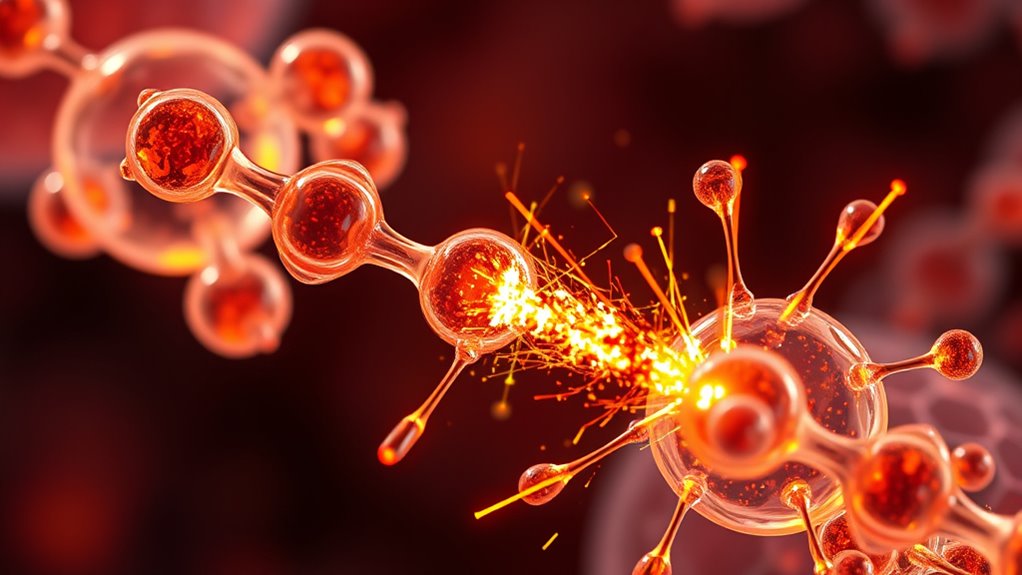
Antioxidants and oxidants constantly compete within your body, maintaining a delicate balance that influences overall health. This balance relies on precise oxidative enzyme regulation, which controls the production of reactive oxygen species, preventing excessive damage. When oxidants dominate, cellular stress increases, but antioxidants step in through signaling pathways that activate protective responses. These antioxidant signaling pathways help your cells adapt by boosting antioxidant production or enhancing repair mechanisms. Maintaining this equilibrium ensures your cells function properly and reduces the risk of oxidative damage. Disruptions in this balance can lead to disease or accelerated aging. By supporting your body’s natural antioxidant defenses and understanding oxidative enzyme regulation, you can help sustain ideal health and resilience against oxidative stress.
Impact of Antioxidant Molecules on Cellular Components
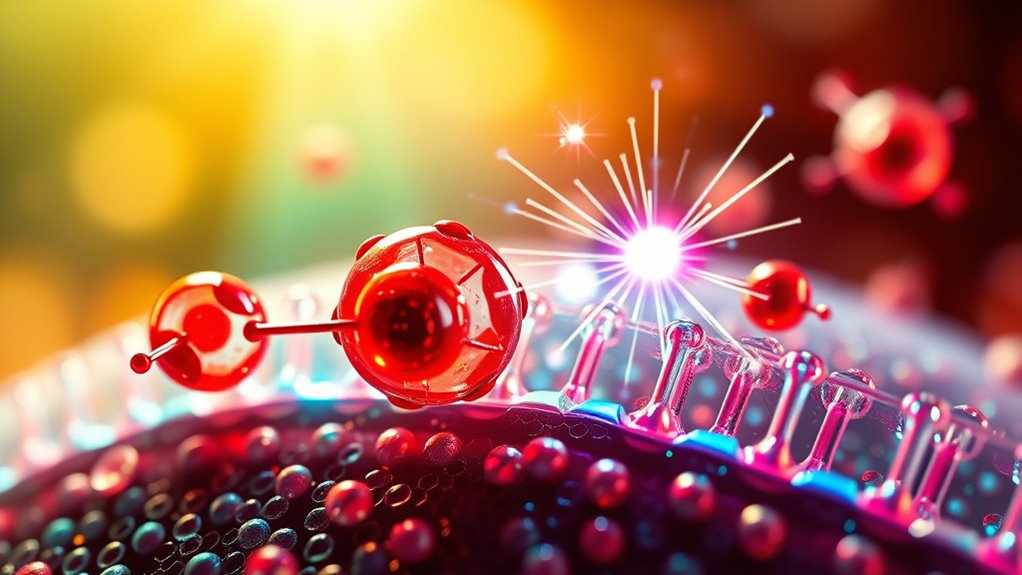
Antioxidant molecules play a essential role in protecting cellular components from oxidative damage. They neutralize free radicals before they harm critical structures like the cell membrane and mitochondria, ensuring cellular integrity. Your cell membrane protection relies on antioxidants such as vitamin E, which stabilizes lipid bilayers and prevents lipid peroxidation. Mitochondrial health depends on antioxidants like CoQ10 that safeguard mitochondrial DNA and enzymes, maintaining efficient energy production. Consider these key impacts:
- Prevents lipid peroxidation, preserving membrane fluidity and integrity.
- Shields mitochondrial DNA from oxidative mutations, supporting energy metabolism.
- Stabilizes mitochondrial membranes, reducing apoptosis triggered by oxidative stress.
Factors Influencing Antioxidant Effectiveness
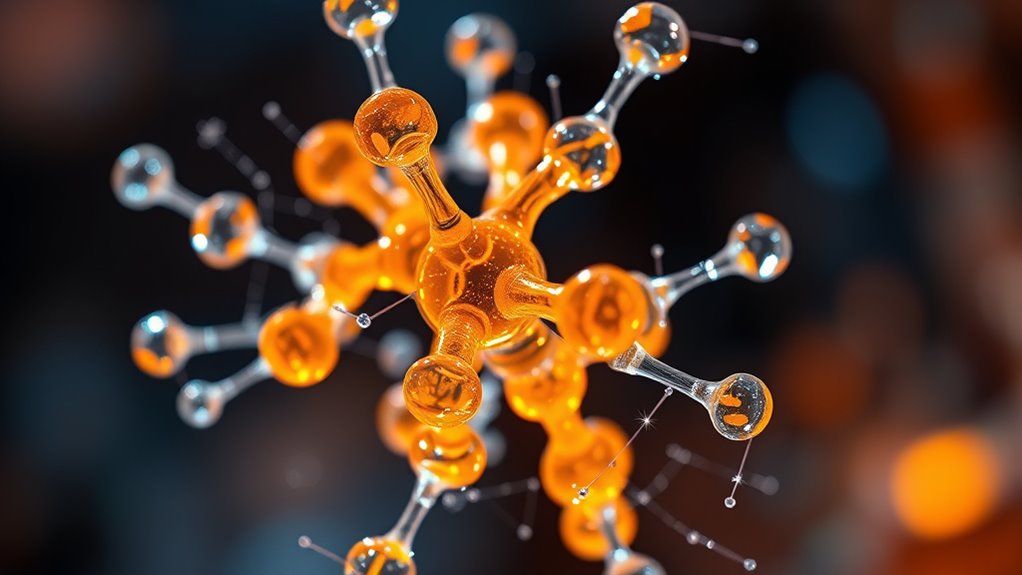
While the protective effects of antioxidant molecules depend on their presence within cellular environments, their efficiency is influenced by several external and internal factors. Genetic variations can alter how your body metabolizes and utilizes antioxidants, affecting their effectiveness. Environmental factors, like pollution, UV exposure, and diet, also play a significant role. These elements can either enhance or diminish antioxidant activity.
| Factor | Impact |
|---|---|
| Genetic variations | Influence antioxidant metabolism and response |
| Environmental factors | Affect antioxidant stability and availability |
| Dietary intake | Determines antioxidant levels in your system |
| Lifestyle habits | Impact oxidative stress and antioxidant efficiency |
| External stressors | Can deplete antioxidants or impair their function |
Frequently Asked Questions
How Do Antioxidants Distinguish Between Harmful and Beneficial Free Radicals?
You might wonder how antioxidants tell apart harmful free radicals from beneficial ones. They do this through radical scavenging and molecular recognition, where antioxidants identify free radicals based on their structure and reactivity. When they encounter a free radical, antioxidants donate electrons to neutralize it, preventing damage. This selective action helps protect healthy cells while targeting the harmful radicals, maintaining your body’s balance and reducing oxidative stress.
What Role Do Metal Ions Play in Antioxidant Activity?
Did you know metal ions, like iron and copper, are involved in about 50% of oxidative damage? They play a key role in antioxidant activity through metal ion chelation, which prevents harmful reactions. Additionally, antioxidants can interrupt redox cycling by stabilizing these metal ions, stopping free radicals from generating even more damage. This dual action helps protect your cells from oxidative stress and supports overall health.
Can Antioxidants Become Pro-Oxidants Under Certain Conditions?
You might wonder if antioxidants can turn into pro-oxidants. Under certain conditions, like imbalanced oxidant balance or redox cycling, antioxidants can actually promote oxidative stress instead of preventing it. This happens when they interact with metal ions or other molecules, leading to the formation of free radicals. So, while antioxidants generally protect your cells, they can contribute to damage if the environment favors their pro-oxidant activity.
How Do Antioxidants Interact With Cellular Signaling Pathways?
Imagine you’re in a vintage movie scene, where antioxidants act like secret agents. They influence cellular signaling pathways through redox modulation, helping control how signals are transmitted inside your cells. By adjusting the redox state, antioxidants can impact signal transduction, improving cellular responses to stress. You benefit from this delicate balance, as it supports your overall health and helps prevent damage from oxidative stress.
Are Synthetic Antioxidants as Effective as Natural Ones?
When comparing synthetic versus natural antioxidants, you’ll find that their efficacy varies depending on the compound and application. Natural antioxidants, found in fruits and vegetables, often have multiple beneficial compounds working synergistically. Synthetic antioxidants are designed for stability and cost-effectiveness. While some studies show comparable effectiveness, others suggest natural antioxidants may offer broader health benefits. Ultimately, your choice depends on specific needs and desired outcomes.
Conclusion
Now that you understand how antioxidants neutralize free radicals at the molecular level, you might wonder what tips can maximize their power. Could specific foods or lifestyle choices tip the balance in your favor? The science is evolving, revealing new insights every day. Stay curious—your cells’ health depends on it. The real question is, are you ready to access the full potential of antioxidants and protect your body from unseen damage?
